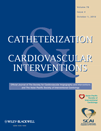Retrograde left-ventricular hemodynamic assessment of mechanical aortic and mitral valve gradients using a high-fidelity pressure wire: A case series†
Conflict of interest: Nothing to report.
Abstract
Noninvasive assessment of mechanical heart valve function with echocardiography is challenging. There are important safety issues when considering placing a standard catheter across a mechanical valve with for invasive hemodynamic measurements. The feasibility of using a high-fidelity micromanometer coronary pressure guide wire to assess hemodynamics across mechanical valves has been reported. Although this method appears feasible, safe, and free of major complication, its application and utility remains obscure and underappreciated. We report a series of two patients with mitral and aortic (St. Jude and Björk-Shiley) mechanical valves in which we successfully used this pressure wire technique to assess valvular function in patients evaluated for repeat surgical valve replacement. We include the first report of this guide wire technique to assess hemodynamics across a Björk–Shiley single-tilting disk valve. © 2010 Wiley-Liss, Inc.




